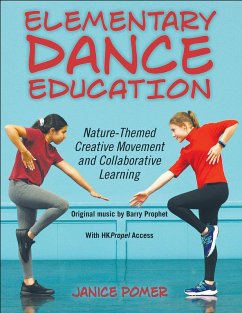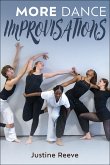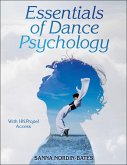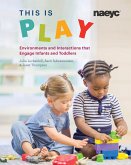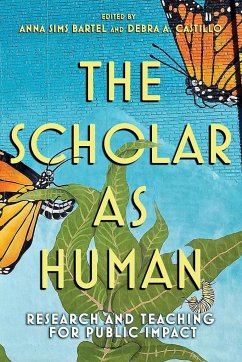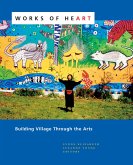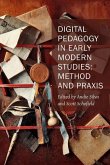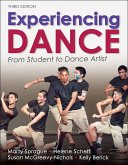- Broschiertes Buch
- Merkliste
- Auf die Merkliste
- Bewerten Bewerten
- Teilen
- Produkt teilen
- Produkterinnerung
- Produkterinnerung
Over 70 easy-to-implement movement activities and exercises for students in grades K-6. Activity variations included for younger and older children. For use in both PE and general classrooms. Comes with 90 minutes of music to inspire exploration, 75 photos to illustrate exercises, video links, discussion questions, and journal prompts.
Andere Kunden interessierten sich auch für
![More Dance Improvisations More Dance Improvisations]() Justine ReeveMore Dance Improvisations38,99 €
Justine ReeveMore Dance Improvisations38,99 €![Essentials of Dance Psychology Essentials of Dance Psychology]() Sanna Nordin-BatesEssentials of Dance Psychology106,99 €
Sanna Nordin-BatesEssentials of Dance Psychology106,99 €![This is Play This is Play]() Julia LuckenbillThis is Play45,99 €
Julia LuckenbillThis is Play45,99 €![The Scholar as Human The Scholar as Human]() The Scholar as Human21,99 €
The Scholar as Human21,99 €![Works of Heart Works of Heart]() Lynne ElizabethWorks of Heart34,99 €
Lynne ElizabethWorks of Heart34,99 €![Digital Pedagogy in Early Modern Studies - Method and Praxis Digital Pedagogy in Early Modern Studies - Method and Praxis]() Andie SilvaDigital Pedagogy in Early Modern Studies - Method and Praxis79,99 €
Andie SilvaDigital Pedagogy in Early Modern Studies - Method and Praxis79,99 €![Experiencing Dance Experiencing Dance]() Marty SpragueExperiencing Dance116,99 €
Marty SpragueExperiencing Dance116,99 €-
-
-
Over 70 easy-to-implement movement activities and exercises for students in grades K-6. Activity variations included for younger and older children. For use in both PE and general classrooms. Comes with 90 minutes of music to inspire exploration, 75 photos to illustrate exercises, video links, discussion questions, and journal prompts.
Hinweis: Dieser Artikel kann nur an eine deutsche Lieferadresse ausgeliefert werden.
Hinweis: Dieser Artikel kann nur an eine deutsche Lieferadresse ausgeliefert werden.
Produktdetails
- Produktdetails
- Verlag: Human Kinetics Publishers
- Seitenzahl: 296
- Erscheinungstermin: 10. November 2022
- Englisch
- Abmessung: 216mm x 287mm x 23mm
- Gewicht: 866g
- ISBN-13: 9781718202955
- ISBN-10: 1718202954
- Artikelnr.: 73642363
- Herstellerkennzeichnung
- Libri GmbH
- Europaallee 1
- 36244 Bad Hersfeld
- gpsr@libri.de
- Verlag: Human Kinetics Publishers
- Seitenzahl: 296
- Erscheinungstermin: 10. November 2022
- Englisch
- Abmessung: 216mm x 287mm x 23mm
- Gewicht: 866g
- ISBN-13: 9781718202955
- ISBN-10: 1718202954
- Artikelnr.: 73642363
- Herstellerkennzeichnung
- Libri GmbH
- Europaallee 1
- 36244 Bad Hersfeld
- gpsr@libri.de
Janice Pomer has been teaching, performing, and creating in the fields of dance, music, and theatre in Canada since 1976. Based in Toronto (Tkaronto), Ontario, Janice offers dance and creative movement experiences for learners of all ages and abilities in urban, rural, northern, and First Nations communities by visiting schools, postsecondary institutes, dance studios, and cultural centers. Pomer is the author of two previous Human Kinetics titles: Perpetual Motion: Creative Movement Exercises for Dance & Dramatic Arts (2002) and Dance Composition: An Interrelated Arts Approach (2009). She creates study guides for boards of education, provides dance resources for dance companies and festivals, and designs interactive school tours and programs for art galleries and museums that incorporate creative movement as the catalyst for deepening students’ understanding and appreciation of the exhibits. Barry Prophet is a composer, sound artist, installation artist, sculptor, and educator whose music has appeared in galleries and theatres in Canada, the United States, and Europe. Creating unique sounds since 1979, he has been praised for his innovativeness: “Prophet gently blows the doors off our settled notions of timbre and tonality” (Robert Everett-Green in Globe and Mail). He performs traditional and experimental percussion (including his microtonally tuned glass percussion performance sculptures), electro-acoustic compositions, and environmental sound art. Barry’s outdoor interactive sound sculptures include “Synthecycletron,” commissioned by New Adventures in Sound Art as a seasonally permanent attraction on Toronto Island (2007-2018), and “Sound Booth,” which was part of W.K.P. Kennedy Gallery’s Ice Follies 2010 exhibition and was later featured in the book Mobitecture: Architecture on the Move (Phaidon, 2017).
Chapter 1. Basic Elements of Dance
The first chapter contains five foundation exercises that have a series of
pedagogic variations to deepen students’ understanding of the basic
elements of dance. Because many of you are working with novice movers, it’s
important that you introduce these exercises to your students before moving
on to the other exercises in this book. The sixth exercise, Collective
Observation, reinforces the importance of discussion and shared
observations introduced in the five fundamental exercises. This exercise
expands students’ observation skills and strengthens trust between fellow
students. The process will support students throughout their artistic
journey and can be applied to subjects across the curriculum.
1.1 Exploring Shapes
1.2 Exploring Motion
1.3 Exploring Time
1.4 Exploring Space
1.5 Exploring Energy
1.6 Collective Observation
Chapter 2. Plants
The second chapter explores a variety of growing things that have, or will
have, roots. Differing shapes, textures, and environments played a part in
the selection of this grouping. On-the-spot movement dynamics will be the
common denominator for much of the choreography. Each plant (or seed) has
unique characteristics that can inspire dynamic movement phrases and
choreography.
2.1 Trees
2.2 Flowers
2.3 Vines
2.4 Tall Grasses
2.5 The Three Sisters
Chapter 3. Animals
Each animal-inspired exercise begins with a simple 16-beat foundation dance
based on actions associated with an animal in a specific animal grouping.
The foundation dance is used to explore some of the animals’ behavioral
traits. Students are then encouraged to create their own dances inspired by
other animals within the specific group. For example, the exercise Horns,
Antlers, Hooves, and Herds presents a foundation dance inspired by caribou
migration and later invites students to create dances inspired by buffalo
and musk ox as well as gazelles and antelope.
3.1 Birds of a Feather
3.2 Wildcats
3.3 Horns, Antlers, Hooves, and Herds
3.4 Reptiles With Scales and Shells
3.5 Spiders and Insects
3.6 Rodents
3.7 Animal Anthology (Kindergarten Through Grade 3)
3.8 Endangered Species (Grades 4 Through 6)
Chapter 4. Water
We are all bodies of water. When we are born, our bodies contain 75 percent
water, which is almost the same percentage of water that covers the earth.
Water is in the ground, in the air, and in the food we eat. The movement
exercises in this chapter examine some of the many ways water moves and
influences us: its cycles and currents and its life-giving and destructive
forces. Each of the exercises in this chapter can be extended into in-depth
choreographic pieces for novice and experienced movers.
4.1 Water Words
4.2 Waves
4.3 Frost and Snow
4.4 Rain
4.5 Water Cycle
4.6 Drought
4.7 Water Pollution (Grades 4 Through 6)
4.8 Wetland Habitats
Chapter 5. Earth
The exercises in this chapter are based on surface textures and shapes, and
underground earth forces that can be felt and seen. These movement
explorations will draw students’ attention to the ways our planet supports
us, the way they travel upon it, and the internal pressures that continue
to reshape it.
5.1 Earth Words
5.2 Terrains
5.3 Rocks and Sand
5.4 Tectonic Plates
5.5 Volcanoes
5.6 Mapping the Land
Chapter 6. Sky
Human beings have been studying the sky since the dawn of mankind; winds
and weather impact our daily lives, and the stars and night skies continue
to inspire us to dream of other worlds. In this chapter, students will look
to the skies from multiple perspectives: personal observations, scientific
knowledge, and traditional folktales or origin stories created to explain
eclipses and the distant planets.
6.1 Clouds
6.2 Thunder and Lightning
6.3 Painting the Sky
6.4 Sun and Moon
6.5 Eclipses
6.6 Gravitational Forces
6.7 The Planets
Chapter 7. People
Humans are mammals, and like mammals and other living things, humans
travel, have families, build communities, and communicate. In this chapter,
students will revisit some of the previous exercises and examine how they
relate to humans, specifically how the actions of their families, friends,
and communities are closely linked to the patterns that govern plants,
animals, water, earth, and sky. Unlike previous exercises, in this chapter,
there is minimal instruction to guide you. The first two exercises provide
direction, but after that you and your class decide how to explore,
structure, and create the dances.
People and Plants
7.1 Revisiting Maple Keys
7.2 Revisiting the Three Sisters
People and Animals
7.3 Revisiting Teamwork
7.4 Revisiting Herd Migrations
People and Water
7.5 Revisiting Snow
7.6 Revisiting the Water Cycle, Drought, and Floods
People and Earth
7.7 Revisiting Tectonic Plates
7.8 Revisiting Volcanoes
People and Sky
7.9 Revisiting the Moon
7.10 Revisiting Our Planet
Chapter 8. Other Wonders
The world is filled with wonders. The final chapter contains a list of
fascinating natural wonders to explore.
Plants
Cacti and the Desert Environment, Carnivorous Plants, Ferns, Mushrooms and
Fungi
Animals
Flightless Birds; The Platypus, Jellyfish, and Other Unique Animals; Animal
Metamorphosis; Animal Architects
Water
Tsunamis, Subterranean Rivers, Hurricanes and Typhoons, Icebergs
Earth
The Carbon Cycle, Earth’s Core, Gemstones, Fossil Sites and Tar Pits
Sky
Comets, Constellations, Supernovas, Our Galaxy
The first chapter contains five foundation exercises that have a series of
pedagogic variations to deepen students’ understanding of the basic
elements of dance. Because many of you are working with novice movers, it’s
important that you introduce these exercises to your students before moving
on to the other exercises in this book. The sixth exercise, Collective
Observation, reinforces the importance of discussion and shared
observations introduced in the five fundamental exercises. This exercise
expands students’ observation skills and strengthens trust between fellow
students. The process will support students throughout their artistic
journey and can be applied to subjects across the curriculum.
1.1 Exploring Shapes
1.2 Exploring Motion
1.3 Exploring Time
1.4 Exploring Space
1.5 Exploring Energy
1.6 Collective Observation
Chapter 2. Plants
The second chapter explores a variety of growing things that have, or will
have, roots. Differing shapes, textures, and environments played a part in
the selection of this grouping. On-the-spot movement dynamics will be the
common denominator for much of the choreography. Each plant (or seed) has
unique characteristics that can inspire dynamic movement phrases and
choreography.
2.1 Trees
2.2 Flowers
2.3 Vines
2.4 Tall Grasses
2.5 The Three Sisters
Chapter 3. Animals
Each animal-inspired exercise begins with a simple 16-beat foundation dance
based on actions associated with an animal in a specific animal grouping.
The foundation dance is used to explore some of the animals’ behavioral
traits. Students are then encouraged to create their own dances inspired by
other animals within the specific group. For example, the exercise Horns,
Antlers, Hooves, and Herds presents a foundation dance inspired by caribou
migration and later invites students to create dances inspired by buffalo
and musk ox as well as gazelles and antelope.
3.1 Birds of a Feather
3.2 Wildcats
3.3 Horns, Antlers, Hooves, and Herds
3.4 Reptiles With Scales and Shells
3.5 Spiders and Insects
3.6 Rodents
3.7 Animal Anthology (Kindergarten Through Grade 3)
3.8 Endangered Species (Grades 4 Through 6)
Chapter 4. Water
We are all bodies of water. When we are born, our bodies contain 75 percent
water, which is almost the same percentage of water that covers the earth.
Water is in the ground, in the air, and in the food we eat. The movement
exercises in this chapter examine some of the many ways water moves and
influences us: its cycles and currents and its life-giving and destructive
forces. Each of the exercises in this chapter can be extended into in-depth
choreographic pieces for novice and experienced movers.
4.1 Water Words
4.2 Waves
4.3 Frost and Snow
4.4 Rain
4.5 Water Cycle
4.6 Drought
4.7 Water Pollution (Grades 4 Through 6)
4.8 Wetland Habitats
Chapter 5. Earth
The exercises in this chapter are based on surface textures and shapes, and
underground earth forces that can be felt and seen. These movement
explorations will draw students’ attention to the ways our planet supports
us, the way they travel upon it, and the internal pressures that continue
to reshape it.
5.1 Earth Words
5.2 Terrains
5.3 Rocks and Sand
5.4 Tectonic Plates
5.5 Volcanoes
5.6 Mapping the Land
Chapter 6. Sky
Human beings have been studying the sky since the dawn of mankind; winds
and weather impact our daily lives, and the stars and night skies continue
to inspire us to dream of other worlds. In this chapter, students will look
to the skies from multiple perspectives: personal observations, scientific
knowledge, and traditional folktales or origin stories created to explain
eclipses and the distant planets.
6.1 Clouds
6.2 Thunder and Lightning
6.3 Painting the Sky
6.4 Sun and Moon
6.5 Eclipses
6.6 Gravitational Forces
6.7 The Planets
Chapter 7. People
Humans are mammals, and like mammals and other living things, humans
travel, have families, build communities, and communicate. In this chapter,
students will revisit some of the previous exercises and examine how they
relate to humans, specifically how the actions of their families, friends,
and communities are closely linked to the patterns that govern plants,
animals, water, earth, and sky. Unlike previous exercises, in this chapter,
there is minimal instruction to guide you. The first two exercises provide
direction, but after that you and your class decide how to explore,
structure, and create the dances.
People and Plants
7.1 Revisiting Maple Keys
7.2 Revisiting the Three Sisters
People and Animals
7.3 Revisiting Teamwork
7.4 Revisiting Herd Migrations
People and Water
7.5 Revisiting Snow
7.6 Revisiting the Water Cycle, Drought, and Floods
People and Earth
7.7 Revisiting Tectonic Plates
7.8 Revisiting Volcanoes
People and Sky
7.9 Revisiting the Moon
7.10 Revisiting Our Planet
Chapter 8. Other Wonders
The world is filled with wonders. The final chapter contains a list of
fascinating natural wonders to explore.
Plants
Cacti and the Desert Environment, Carnivorous Plants, Ferns, Mushrooms and
Fungi
Animals
Flightless Birds; The Platypus, Jellyfish, and Other Unique Animals; Animal
Metamorphosis; Animal Architects
Water
Tsunamis, Subterranean Rivers, Hurricanes and Typhoons, Icebergs
Earth
The Carbon Cycle, Earth’s Core, Gemstones, Fossil Sites and Tar Pits
Sky
Comets, Constellations, Supernovas, Our Galaxy
Chapter 1. Basic Elements of Dance
The first chapter contains five foundation exercises that have a series of
pedagogic variations to deepen students’ understanding of the basic
elements of dance. Because many of you are working with novice movers, it’s
important that you introduce these exercises to your students before moving
on to the other exercises in this book. The sixth exercise, Collective
Observation, reinforces the importance of discussion and shared
observations introduced in the five fundamental exercises. This exercise
expands students’ observation skills and strengthens trust between fellow
students. The process will support students throughout their artistic
journey and can be applied to subjects across the curriculum.
1.1 Exploring Shapes
1.2 Exploring Motion
1.3 Exploring Time
1.4 Exploring Space
1.5 Exploring Energy
1.6 Collective Observation
Chapter 2. Plants
The second chapter explores a variety of growing things that have, or will
have, roots. Differing shapes, textures, and environments played a part in
the selection of this grouping. On-the-spot movement dynamics will be the
common denominator for much of the choreography. Each plant (or seed) has
unique characteristics that can inspire dynamic movement phrases and
choreography.
2.1 Trees
2.2 Flowers
2.3 Vines
2.4 Tall Grasses
2.5 The Three Sisters
Chapter 3. Animals
Each animal-inspired exercise begins with a simple 16-beat foundation dance
based on actions associated with an animal in a specific animal grouping.
The foundation dance is used to explore some of the animals’ behavioral
traits. Students are then encouraged to create their own dances inspired by
other animals within the specific group. For example, the exercise Horns,
Antlers, Hooves, and Herds presents a foundation dance inspired by caribou
migration and later invites students to create dances inspired by buffalo
and musk ox as well as gazelles and antelope.
3.1 Birds of a Feather
3.2 Wildcats
3.3 Horns, Antlers, Hooves, and Herds
3.4 Reptiles With Scales and Shells
3.5 Spiders and Insects
3.6 Rodents
3.7 Animal Anthology (Kindergarten Through Grade 3)
3.8 Endangered Species (Grades 4 Through 6)
Chapter 4. Water
We are all bodies of water. When we are born, our bodies contain 75 percent
water, which is almost the same percentage of water that covers the earth.
Water is in the ground, in the air, and in the food we eat. The movement
exercises in this chapter examine some of the many ways water moves and
influences us: its cycles and currents and its life-giving and destructive
forces. Each of the exercises in this chapter can be extended into in-depth
choreographic pieces for novice and experienced movers.
4.1 Water Words
4.2 Waves
4.3 Frost and Snow
4.4 Rain
4.5 Water Cycle
4.6 Drought
4.7 Water Pollution (Grades 4 Through 6)
4.8 Wetland Habitats
Chapter 5. Earth
The exercises in this chapter are based on surface textures and shapes, and
underground earth forces that can be felt and seen. These movement
explorations will draw students’ attention to the ways our planet supports
us, the way they travel upon it, and the internal pressures that continue
to reshape it.
5.1 Earth Words
5.2 Terrains
5.3 Rocks and Sand
5.4 Tectonic Plates
5.5 Volcanoes
5.6 Mapping the Land
Chapter 6. Sky
Human beings have been studying the sky since the dawn of mankind; winds
and weather impact our daily lives, and the stars and night skies continue
to inspire us to dream of other worlds. In this chapter, students will look
to the skies from multiple perspectives: personal observations, scientific
knowledge, and traditional folktales or origin stories created to explain
eclipses and the distant planets.
6.1 Clouds
6.2 Thunder and Lightning
6.3 Painting the Sky
6.4 Sun and Moon
6.5 Eclipses
6.6 Gravitational Forces
6.7 The Planets
Chapter 7. People
Humans are mammals, and like mammals and other living things, humans
travel, have families, build communities, and communicate. In this chapter,
students will revisit some of the previous exercises and examine how they
relate to humans, specifically how the actions of their families, friends,
and communities are closely linked to the patterns that govern plants,
animals, water, earth, and sky. Unlike previous exercises, in this chapter,
there is minimal instruction to guide you. The first two exercises provide
direction, but after that you and your class decide how to explore,
structure, and create the dances.
People and Plants
7.1 Revisiting Maple Keys
7.2 Revisiting the Three Sisters
People and Animals
7.3 Revisiting Teamwork
7.4 Revisiting Herd Migrations
People and Water
7.5 Revisiting Snow
7.6 Revisiting the Water Cycle, Drought, and Floods
People and Earth
7.7 Revisiting Tectonic Plates
7.8 Revisiting Volcanoes
People and Sky
7.9 Revisiting the Moon
7.10 Revisiting Our Planet
Chapter 8. Other Wonders
The world is filled with wonders. The final chapter contains a list of
fascinating natural wonders to explore.
Plants
Cacti and the Desert Environment, Carnivorous Plants, Ferns, Mushrooms and
Fungi
Animals
Flightless Birds; The Platypus, Jellyfish, and Other Unique Animals; Animal
Metamorphosis; Animal Architects
Water
Tsunamis, Subterranean Rivers, Hurricanes and Typhoons, Icebergs
Earth
The Carbon Cycle, Earth’s Core, Gemstones, Fossil Sites and Tar Pits
Sky
Comets, Constellations, Supernovas, Our Galaxy
The first chapter contains five foundation exercises that have a series of
pedagogic variations to deepen students’ understanding of the basic
elements of dance. Because many of you are working with novice movers, it’s
important that you introduce these exercises to your students before moving
on to the other exercises in this book. The sixth exercise, Collective
Observation, reinforces the importance of discussion and shared
observations introduced in the five fundamental exercises. This exercise
expands students’ observation skills and strengthens trust between fellow
students. The process will support students throughout their artistic
journey and can be applied to subjects across the curriculum.
1.1 Exploring Shapes
1.2 Exploring Motion
1.3 Exploring Time
1.4 Exploring Space
1.5 Exploring Energy
1.6 Collective Observation
Chapter 2. Plants
The second chapter explores a variety of growing things that have, or will
have, roots. Differing shapes, textures, and environments played a part in
the selection of this grouping. On-the-spot movement dynamics will be the
common denominator for much of the choreography. Each plant (or seed) has
unique characteristics that can inspire dynamic movement phrases and
choreography.
2.1 Trees
2.2 Flowers
2.3 Vines
2.4 Tall Grasses
2.5 The Three Sisters
Chapter 3. Animals
Each animal-inspired exercise begins with a simple 16-beat foundation dance
based on actions associated with an animal in a specific animal grouping.
The foundation dance is used to explore some of the animals’ behavioral
traits. Students are then encouraged to create their own dances inspired by
other animals within the specific group. For example, the exercise Horns,
Antlers, Hooves, and Herds presents a foundation dance inspired by caribou
migration and later invites students to create dances inspired by buffalo
and musk ox as well as gazelles and antelope.
3.1 Birds of a Feather
3.2 Wildcats
3.3 Horns, Antlers, Hooves, and Herds
3.4 Reptiles With Scales and Shells
3.5 Spiders and Insects
3.6 Rodents
3.7 Animal Anthology (Kindergarten Through Grade 3)
3.8 Endangered Species (Grades 4 Through 6)
Chapter 4. Water
We are all bodies of water. When we are born, our bodies contain 75 percent
water, which is almost the same percentage of water that covers the earth.
Water is in the ground, in the air, and in the food we eat. The movement
exercises in this chapter examine some of the many ways water moves and
influences us: its cycles and currents and its life-giving and destructive
forces. Each of the exercises in this chapter can be extended into in-depth
choreographic pieces for novice and experienced movers.
4.1 Water Words
4.2 Waves
4.3 Frost and Snow
4.4 Rain
4.5 Water Cycle
4.6 Drought
4.7 Water Pollution (Grades 4 Through 6)
4.8 Wetland Habitats
Chapter 5. Earth
The exercises in this chapter are based on surface textures and shapes, and
underground earth forces that can be felt and seen. These movement
explorations will draw students’ attention to the ways our planet supports
us, the way they travel upon it, and the internal pressures that continue
to reshape it.
5.1 Earth Words
5.2 Terrains
5.3 Rocks and Sand
5.4 Tectonic Plates
5.5 Volcanoes
5.6 Mapping the Land
Chapter 6. Sky
Human beings have been studying the sky since the dawn of mankind; winds
and weather impact our daily lives, and the stars and night skies continue
to inspire us to dream of other worlds. In this chapter, students will look
to the skies from multiple perspectives: personal observations, scientific
knowledge, and traditional folktales or origin stories created to explain
eclipses and the distant planets.
6.1 Clouds
6.2 Thunder and Lightning
6.3 Painting the Sky
6.4 Sun and Moon
6.5 Eclipses
6.6 Gravitational Forces
6.7 The Planets
Chapter 7. People
Humans are mammals, and like mammals and other living things, humans
travel, have families, build communities, and communicate. In this chapter,
students will revisit some of the previous exercises and examine how they
relate to humans, specifically how the actions of their families, friends,
and communities are closely linked to the patterns that govern plants,
animals, water, earth, and sky. Unlike previous exercises, in this chapter,
there is minimal instruction to guide you. The first two exercises provide
direction, but after that you and your class decide how to explore,
structure, and create the dances.
People and Plants
7.1 Revisiting Maple Keys
7.2 Revisiting the Three Sisters
People and Animals
7.3 Revisiting Teamwork
7.4 Revisiting Herd Migrations
People and Water
7.5 Revisiting Snow
7.6 Revisiting the Water Cycle, Drought, and Floods
People and Earth
7.7 Revisiting Tectonic Plates
7.8 Revisiting Volcanoes
People and Sky
7.9 Revisiting the Moon
7.10 Revisiting Our Planet
Chapter 8. Other Wonders
The world is filled with wonders. The final chapter contains a list of
fascinating natural wonders to explore.
Plants
Cacti and the Desert Environment, Carnivorous Plants, Ferns, Mushrooms and
Fungi
Animals
Flightless Birds; The Platypus, Jellyfish, and Other Unique Animals; Animal
Metamorphosis; Animal Architects
Water
Tsunamis, Subterranean Rivers, Hurricanes and Typhoons, Icebergs
Earth
The Carbon Cycle, Earth’s Core, Gemstones, Fossil Sites and Tar Pits
Sky
Comets, Constellations, Supernovas, Our Galaxy

